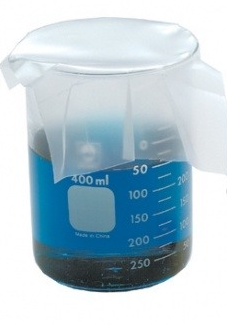If the mol ratio of nitrogen and oxygen is 4:14:1, what is the ratio of their solubilities in terms of mol fractions? Take k_H = 3.3 xx 10^7 "torr"kH=3.3×107torr for "N"_2(g)N2(g) and 6.6 xx 10^7 "torr"6.6×107torr for "O"_2(g)O2(g).
1 Answer
You should consider whether the question wants
There are two things you should be thinking about here:
- What is Henry's law in terms of mol fractions?
- What does knowing the ratio of
"N"_2:"O"_2N2:O2 in air tell you about their partial pressures?
Setting up the solution is usually the hard part. Imagine a beaker of water that has air dissolved in it, but there is, say, parafilm on it so that it is a closed container. Kind of like this, but with transparent water:

What you are looking for is the ratio of the solubilities on the mol fraction scale. It may or may not be
Henry's law in terms of mol fractions for the solute in particularly-dilute solutions is:
bb(P_j = chi_(j(v))k_(H,j)) where:
P_j is the partial pressure of solutej above the solution.chi_(j(v)) is the mol fraction of solutej in the vapor phase (v ), that is, above the solution.k_(H,j) is the Henry's law constant of solutej , andk_(H,j) approaches the pure vapor pressureP_j^"*" aschi_(j(l)) -> 1 (since the solute particles surround the solvent particles completely, and vaporize most easily).
Writing Henry's law for
P_(N_2) = chi_(N_2(v))k_(H,N_2)
P_(O_2) = chi_(O_2(v))k_(H,O_2)
But from Dalton's law of partial pressures for ideal gases, we have:
P_(t ot) = P_(N_2) + P_(O_2)
= 0.78P_(t ot) + 0.21P_(t ot) + stackrel("Other")overbrace(0.01P_(t ot))
Thus, we can rewrite Henry's law as:
0.78P_(t ot) = chi_(N_2(v))k_(H,N_2)
0.21P_(t ot) = chi_(O_2(v))k_(H,O_2)
Finding the ratio of their mol fraction solubilities, we then have:
(0.78P_(t ot))/(0.21P_(t ot)) = (chi_(N_2(v))k_(H,N_2))/(chi_(O_2(v))k_(H,O_2))
=> (chi_(N_2(v)))/(chi_(O_2(v))) = 3.71(k_(H,O_2)/k_(H,N_2))
= 3.71((3.3 xx 10^7 "torr")/(6.6 xx 10^7 "torr"))
= 1.86
That's using a mol ratio of
color(blue)((chi_(N_2(v)))/(chi_(O_2(v)))) = 4((3.3 xx 10^7 "torr")/(6.6 xx 10^7 "torr"))
= color(blue)(2:1) ,color(blue)("N"_2:"O"_2)
If the question wants the ratio of
In the end, it is just the mol ratio in air, weighted by the reciprocal ratio of the Henry's law constants.

